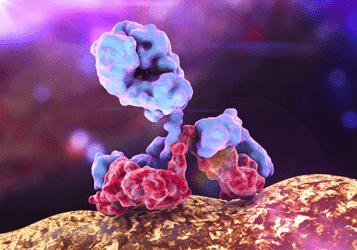- Home
- Products
- Customized ADCs
- TNFSF11
- Anti-TNFSF11 (Denosumab)-SPDB-DM4 ADC
Anti-TNFSF11 (Denosumab)-SPDB-DM4 ADC (CAT#: ADC-W-2235)
This ADC product is comprised of an anti-TNFSF11 monoclonal antibody conjugated via a SPDB linker to DM4. The DM4 is targeted to certain cancers by immunerecognition and delivered into cancer cells via receptor mediated endocytosis. Within the cell, DM1 binds to tubulins, interrupts microtubule dynamics, and subsequently, induces cell death.
- ADC Target
- ADC Antibody
- ADC Linker
- ADC payload drug
- Name
- TNFSF11
- Alternative Names
- TNFSF11; tumor necrosis factor (ligand) superfamily, member 11; tumor necrosis factor ligand superfamily member 11; CD254; ODF; OPGL; RANKL; TRANCE; osteoprotegerin ligand; osteoclast differentiation factor; TNF-related activation-induced cytokine; receptor activator of nuclear factor kappa B ligand; receptor activator of nuclear factor kappa-B ligand; sOdf; OPTB2; hRANKL2;
- Target Entrez Gene ID
- 8600
- Target UniProt ID
- O14788
- Overview
- This gene encodes a member of the tumor necrosis factor (TNF) cytokine family which is a ligand for osteoprotegerin and functions as a key factor for osteoclast differentiation and activation. This protein was shown to be a dentritic cell survival factor and is involved in the regulation of T cell-dependent immune response. T cell activation was reported to induce expression of this gene and lead to an increase of osteoclastogenesis and bone loss. This protein was shown to activate antiapoptotic kinase AKT/PKB through a signaling complex involving SRC kinase and tumor necrosis factor receptor-associated factor (TRAF) 6, which indicated this protein may have a role in the regulation of cell apoptosis. Targeted disruption of the related gene in mice led to severe osteopetrosis and a lack of osteoclasts. The deficient mice exhibited defects in early differentiation of T and B lymphocytes, and failed to form lobulo-alveolar mammary structures during pregnancy. Two alternatively spliced transcript variants have been found.
- Overview
- Human Anti-TNFSF11 IgG2 antibody, Denosumab
- Generic name
- Denosumab
- Host animal
- Human
- Name
- SPDB (N-succinimidyl-4-(2-pyridyldithio)butyrate)
- Description
- Disulfide Linkers, are extensively exploited as a chemically labile linkage. Since the release of disulfide-linked drugs requires a cytoplasmic thiol cofactor, such as glutathione (GSH). Disulfides maintain stable at physiological pH and only when ADCs are internalized inside cells, the cytosol provides reducing environment including intracellular enzyme protein disulfide isomerase, or similar enzymes, drugs can be released.
- Name
- DM4 (N2'-Deacetyl-N2'-(4-mercapto-4-methyl-1-oxopentyl)maytansine)
- Description
- Derived from Maytansinoid,a group of cytotoxins structurally similar to rifamycin, geldanamycin, and ansatrienin. The eponymous natural cytotoxic agent maytansine is a 19-member lactam (ansa macrolide) structure originally isolated from the Ethiopian shrub Maytenus ovatus. Maytansinoids can bind to tubulin at or near the vinblastine-binding site, which interfere the formation of microtubules and depolymerize already formed microtubules, inducing mitotic arrest in the intoxicated cells.
For Research Use Only. NOT FOR CLINICAL USE.
Related Products
- Anti-CSF2 (Namilumab)-SPDB-DM4 ADC (CAT#: ADC-W-987)
- Anti-HIV-1 (Suvizumab)-SMCC-DM1 ADC (CAT#: ADC-W-2108)
- Anti-IL17RA (Ixekizumab)-SMCC-DM1 ADC (CAT#: ADC-W-1322)
- Anti-MET (Onartuzumab)-MC-MMAF ADC (CAT#: ADC-W-1540)
- Anti-RhD (Morolimumab)-MC-MMAF ADC (CAT#: ADC-W-1726)
- Anti-EGFR (MAb806)-Mc-MMAF ADC (CAT#: ADC-W-394)
- Anti-CD4 (Keliximab)-SMCC-DM1 ADC (CAT#: ADC-W-866)
- Anti-CD3E (Otelixizumab)-MC-Vc-PAB-DMEA-(PEG2)-duocarmycin SA ADC (CAT#: ADC-W-2479)
- Anti-IL1B-MC-Vc-PAB-DMEA-(PEG2)-duocarmycin SA ADC-1 (CAT#: ADC-W-1339)
- Anti-CD33 (Lintuzumab)-SMCC-DM1 ADC (CAT#: ADC-W-812)
Published Data
+ Submit Publications

Scientific Resources
Customer Reviews and FAQs
There are currently no Customer reviews or questions for ADC-W-2235. Click the button above to contact us or submit your feedback about this product.
Quick Links
Other Products
Same Target
Same Linker
Same Payload
| CAT# | Product Name | Linker | Payload |
| ADC-W-2238 | Anti-TNFSF11 (Denosumab)-MC-Vc-PAB-SN38 ADC | MC-Vc-PAB (maleimidocaproyl-valine-citrulline-p-aminobenzoyloxycarbonyl) | SN-38 (7-ethyl-10-hydroxycamptothecin) |
| ADC-W-2239 | Anti-TNFSF11 (Denosumab)-MC-Vc-PAB-DMEA-(PEG2)-duocarmycin SA ADC | MC-Vc-PAB-DMEA-(PEG2) | duocarmycin SA |
| ADC-W-2237 | Anti-TNFSF11 (Denosumab)-MC-Vc-PAB-MMAE ADC | MC-Vc-PAB (maleimidocaproyl-valine-citrulline-p-aminobenzoyloxycarbonyl) | MMAE |
| ADC-W-2236 | Anti-TNFSF11 (Denosumab)-MC-MMAF ADC | MC (maleimidocaproyl) | MMAF |
| ADC-W-2234 | Anti-TNFSF11 (Denosumab)-SMCC-DM1 ADC | SMCC (N-succinimidyl 4-(Nmaleimidomethyl)cyclohexane-1-carboxylate) | DM1 (N2'-Deacetyl-N2'-(3-mercapto-1-oxopropyl)maytansine) |
| CAT# | Product Name | Linker | Payload |
| ADC-W-2621 | Anti-NCAM1 (Lorvotuzumab )-SPDB-DM4 ADC | SPDB (N-succinimidyl-4-(2-pyridyldithio)butyrate) | DM4 (N2'-Deacetyl-N2'-(4-mercapto-4-methyl-1-oxopentyl)maytansine) |
| ADC-W-422 | Anti-ITGAV-SPDB-DM4 ADC | SPDB (N-succinimidyl-4-(2-pyridyldithio)butyrate) | DM4 (N2'-Deacetyl-N2'-(4-mercapto-4-methyl-1-oxopentyl)maytansine) |
| ADC-W-2616 | Anti-MS4A1-SPDB-DM4 ADC | SPDB (N-succinimidyl-4-(2-pyridyldithio)butyrate) | DM4 (N2'-Deacetyl-N2'-(4-mercapto-4-methyl-1-oxopentyl)maytansine) |
| ADC-W-2605 | Anti-ITGB3 (Tadocizumab)-SPDB-DM4 ADC | SPDB (N-succinimidyl-4-(2-pyridyldithio)butyrate) | DM4 (N2'-Deacetyl-N2'-(4-mercapto-4-methyl-1-oxopentyl)maytansine) |
| ADC-W-095 | Anti-LAMP1-SPDB-DM4 ADC-1 | SPDB (N-succinimidyl-4-(2-pyridyldithio)butyrate) | DM4 (N2'-Deacetyl-N2'-(4-mercapto-4-methyl-1-oxopentyl)maytansine) |
| CAT# | Product Name | Linker | Payload |
| ADC-W-095 | Anti-LAMP1-SPDB-DM4 ADC-1 | SPDB (N-succinimidyl-4-(2-pyridyldithio)butyrate) | DM4 (N2'-Deacetyl-N2'-(4-mercapto-4-methyl-1-oxopentyl)maytansine) |
| ADC-W-2595 | Anti-ERBB2 (Trastuzumab)-SPDB-DM4 ADC | SPDB (N-succinimidyl-4-(2-pyridyldithio)butyrate) | DM4 (N2'-Deacetyl-N2'-(4-mercapto-4-methyl-1-oxopentyl)maytansine) |
| ADC-W-469 | Anti-CA6-SPDB-DM4 ADC | SPDB (N-succinimidyl-4-(2-pyridyldithio)butyrate) | DM4 (N2'-Deacetyl-N2'-(4-mercapto-4-methyl-1-oxopentyl)maytansine) |
| ADC-W-422 | Anti-ITGAV-SPDB-DM4 ADC | SPDB (N-succinimidyl-4-(2-pyridyldithio)butyrate) | DM4 (N2'-Deacetyl-N2'-(4-mercapto-4-methyl-1-oxopentyl)maytansine) |
| ADC-W-2621 | Anti-NCAM1 (Lorvotuzumab )-SPDB-DM4 ADC | SPDB (N-succinimidyl-4-(2-pyridyldithio)butyrate) | DM4 (N2'-Deacetyl-N2'-(4-mercapto-4-methyl-1-oxopentyl)maytansine) |
Online Inquiry
Welcome! For price inquiries, please feel free to contact us through the form on the left side. We will get back to you as soon as possible.



